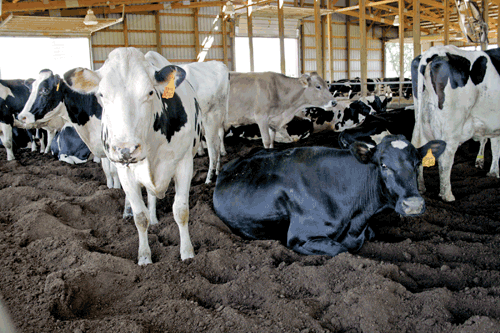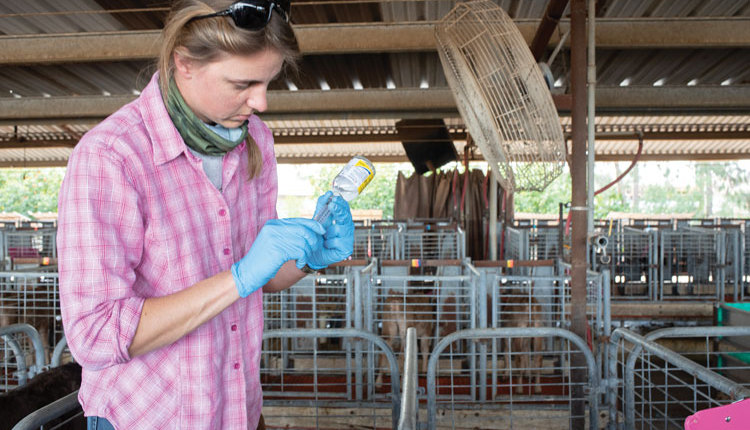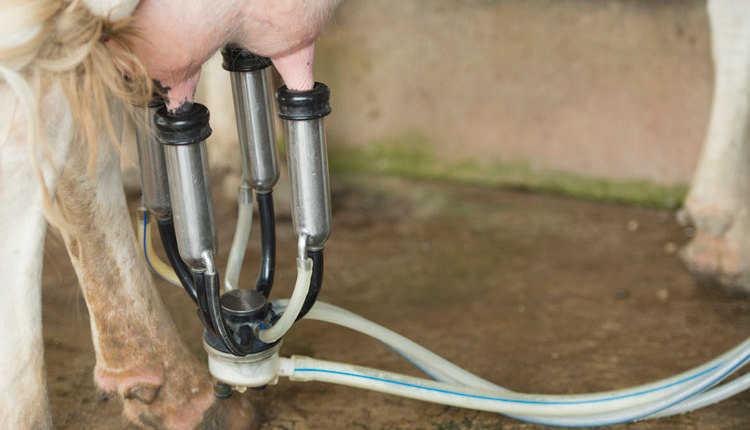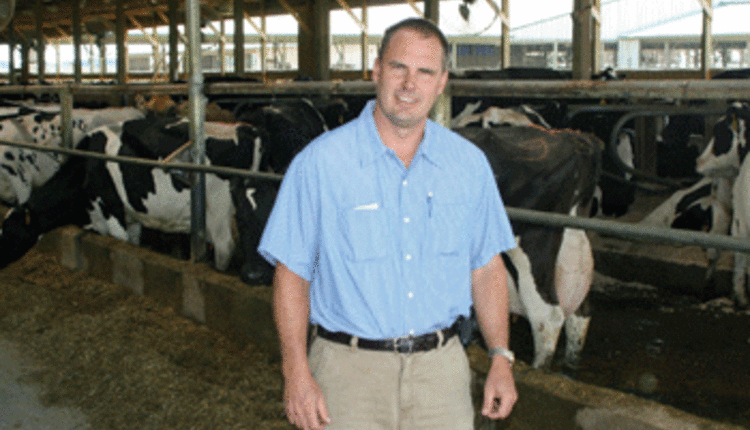The author is a Milk Production Specialist with Land O'Lakes, Inc.

Compost, when managed correctly, can serve as a great tool to improve milk quality. There are many ways to successfully utilize and manage a compost barn.
Despite being a relatively new addition on many dairies, compost barns steadily have been generating a growing amount of interest industry-wide. Used as an alternate housing system, compost barns are used to improve milk production and heat detection, lower somatic cell counts, improve cow health, and minimize manure storage expenses.
As evidence of their growing popularity, word of compost barns has spread across the Atlantic, as witnessed during the recent John Ogonowski Farmer-to-Farmer (FTF) Program in Russia. Several Russian farmers expressed interest in compost barns and inquired about the feasibility of adding one to their operation.
Back home in the United States, the majority of those who have compost barns have been extremely satisfied with the results. Under careful management, including excellent cow preparation, these barns have succeeded in improving milk quality.
However, there are some added costs when employing this technique. For example, the cost of sawdust for bedding has grown sharply more expensive, especially during winter when supply is low and demand is high. Currently, bedding is ranging in cost from 45 to 80 cents per day per cow, depending on the time of year and cost of a semi-load of bedding.
Despite this, with the proper management, these facilities have proven themselves a useful tool. There is not one correct technique to running a successful compost barn. On the contrary, several different management styles have been known to maintain a compost barn successfully. Here is a summary of interviews conducted with several Midwest dairy farmers regarding their management styles.
Kent Swenson, managing partner, Dusty Willow Dairy, LLP, Lakota, N.D. Swenson says the dairy maintains a somatic cell count in the low 200,000s, and since employing a compost barn, "Milk quality and cow comfort has been far better than we could have even hoped for." Because sawdust is both scarce and expensive, Swenson says the operation uses chopped wheat and barley straw, mixed with soybean vines, ground in a tub grinder.
As a means of curing, Swenson says the operation tills twice a day with a 12-inch cultivator and beds every four days with great success. "Even the oldest cows maintain strong feet and legs; they last at least an additional lactation in the compost barn."
Pat Lunemann, owner, Twin Eagle Dairy, Clarissa, Minn. Lunemann was so impressed with the bedding that he removed the mattresses and now is using the same material and the deep-bedded concept in his free stall barn. He says cows take to the stalls and just look more content and comfortable compared to when mattresses were used. Additionally, Lunemann says, his cull rate has dropped considerably. "Once on compost, I have been able to get at least eight cows back to clean health and eating from the bunk that could no longer get around on concrete. Even their somatic cell count went down," he says.
Mark Buntjer, managing partner, Dairyridge, Long Prairie, Minn. Taking a different approach to compost, Buntjer has found his own successful management technique. "I have all my dry and close- up cows on compost. It also serves as my calving pen," he says. The 1,400-cow facility averages 100 dry cows on compost, and Buntjer says those cows freshen well rested and have the feet and leg strength to carry them through the lactation. He tills with a cultivator twice a day going from 12 to 18 inches deep. Additionally, Buntjer hired a local company to lay a 4-inch pad of asphalt underneath the compost for easy cleaning. "The asphalt pad is hot when the compost is removed, so the concept is definitely working," he says.
Mark and Amy Blackwelder, owners, County Line Dairy, Chokio, Minn. The Blackwelders have one-third of their herd of 270 cows on compost and, after a little trial and error, have found an effective formula. "I tried grinding cornstalks last fall, but they were too wet," Mark says of his 1-year-old facility. "Sawdust and fine ground wood shavings are always the best but are getting expensive." Mark has one group that is 30 days in milk and another group that is high production.
Since implementing the compost, their culling rate went from 36 percent to 26 percent. Their approach has been having one cow per 84 square feet. Their son, Brett, says, "Their linear score has dropped considerably since the early and high-lactation groups have been on compost." They add new bedding every six days and contribute their low somatic cell count and cow comfort to tilling twice each day.
Bruce Stone, owner, Stone Dairy, Inc., Henning, Minn. Employing a Bush Hog Rototiller on their compost has worked well at the Stones' dairy. "Rototilling three times per day mixes the bedding up better," Bruce says. "And a load of sawdust lasts much longer." They also topdress with a large, square straw bale that is chopped with a TMR mixer.
All cows 30 days in milk are on the compost, plus those that cannot handle concrete anymore. Bruce is certain a drop in somatic cell count is because of the comfortable environment created by the compost barn.
For those considering implementing a compost barn, there are a few things to keep in mind. A semi-load of bedding currently ranges from $700 to $1,400, and it is important to confirm there is an adequate supply before considering this option. Compost barns were once considered a way for smaller dairies to expand without the manure storage expense, but a compost barn can make a nice addition to a larger free stall barn facility. Regardless of size and scale, compost barns are a great way to enhance cow comfort and improve milk quality.

Despite being a relatively new addition on many dairies, compost barns steadily have been generating a growing amount of interest industry-wide. Used as an alternate housing system, compost barns are used to improve milk production and heat detection, lower somatic cell counts, improve cow health, and minimize manure storage expenses.
As evidence of their growing popularity, word of compost barns has spread across the Atlantic, as witnessed during the recent John Ogonowski Farmer-to-Farmer (FTF) Program in Russia. Several Russian farmers expressed interest in compost barns and inquired about the feasibility of adding one to their operation.
Back home in the United States, the majority of those who have compost barns have been extremely satisfied with the results. Under careful management, including excellent cow preparation, these barns have succeeded in improving milk quality.
However, there are some added costs when employing this technique. For example, the cost of sawdust for bedding has grown sharply more expensive, especially during winter when supply is low and demand is high. Currently, bedding is ranging in cost from 45 to 80 cents per day per cow, depending on the time of year and cost of a semi-load of bedding.
Despite this, with the proper management, these facilities have proven themselves a useful tool. There is not one correct technique to running a successful compost barn. On the contrary, several different management styles have been known to maintain a compost barn successfully. Here is a summary of interviews conducted with several Midwest dairy farmers regarding their management styles.
Kent Swenson, managing partner, Dusty Willow Dairy, LLP, Lakota, N.D. Swenson says the dairy maintains a somatic cell count in the low 200,000s, and since employing a compost barn, "Milk quality and cow comfort has been far better than we could have even hoped for." Because sawdust is both scarce and expensive, Swenson says the operation uses chopped wheat and barley straw, mixed with soybean vines, ground in a tub grinder.
As a means of curing, Swenson says the operation tills twice a day with a 12-inch cultivator and beds every four days with great success. "Even the oldest cows maintain strong feet and legs; they last at least an additional lactation in the compost barn."
Pat Lunemann, owner, Twin Eagle Dairy, Clarissa, Minn. Lunemann was so impressed with the bedding that he removed the mattresses and now is using the same material and the deep-bedded concept in his free stall barn. He says cows take to the stalls and just look more content and comfortable compared to when mattresses were used. Additionally, Lunemann says, his cull rate has dropped considerably. "Once on compost, I have been able to get at least eight cows back to clean health and eating from the bunk that could no longer get around on concrete. Even their somatic cell count went down," he says.
Mark Buntjer, managing partner, Dairyridge, Long Prairie, Minn. Taking a different approach to compost, Buntjer has found his own successful management technique. "I have all my dry and close- up cows on compost. It also serves as my calving pen," he says. The 1,400-cow facility averages 100 dry cows on compost, and Buntjer says those cows freshen well rested and have the feet and leg strength to carry them through the lactation. He tills with a cultivator twice a day going from 12 to 18 inches deep. Additionally, Buntjer hired a local company to lay a 4-inch pad of asphalt underneath the compost for easy cleaning. "The asphalt pad is hot when the compost is removed, so the concept is definitely working," he says.
Mark and Amy Blackwelder, owners, County Line Dairy, Chokio, Minn. The Blackwelders have one-third of their herd of 270 cows on compost and, after a little trial and error, have found an effective formula. "I tried grinding cornstalks last fall, but they were too wet," Mark says of his 1-year-old facility. "Sawdust and fine ground wood shavings are always the best but are getting expensive." Mark has one group that is 30 days in milk and another group that is high production.
Since implementing the compost, their culling rate went from 36 percent to 26 percent. Their approach has been having one cow per 84 square feet. Their son, Brett, says, "Their linear score has dropped considerably since the early and high-lactation groups have been on compost." They add new bedding every six days and contribute their low somatic cell count and cow comfort to tilling twice each day.
Bruce Stone, owner, Stone Dairy, Inc., Henning, Minn. Employing a Bush Hog Rototiller on their compost has worked well at the Stones' dairy. "Rototilling three times per day mixes the bedding up better," Bruce says. "And a load of sawdust lasts much longer." They also topdress with a large, square straw bale that is chopped with a TMR mixer.
All cows 30 days in milk are on the compost, plus those that cannot handle concrete anymore. Bruce is certain a drop in somatic cell count is because of the comfortable environment created by the compost barn.
For those considering implementing a compost barn, there are a few things to keep in mind. A semi-load of bedding currently ranges from $700 to $1,400, and it is important to confirm there is an adequate supply before considering this option. Compost barns were once considered a way for smaller dairies to expand without the manure storage expense, but a compost barn can make a nice addition to a larger free stall barn facility. Regardless of size and scale, compost barns are a great way to enhance cow comfort and improve milk quality.









